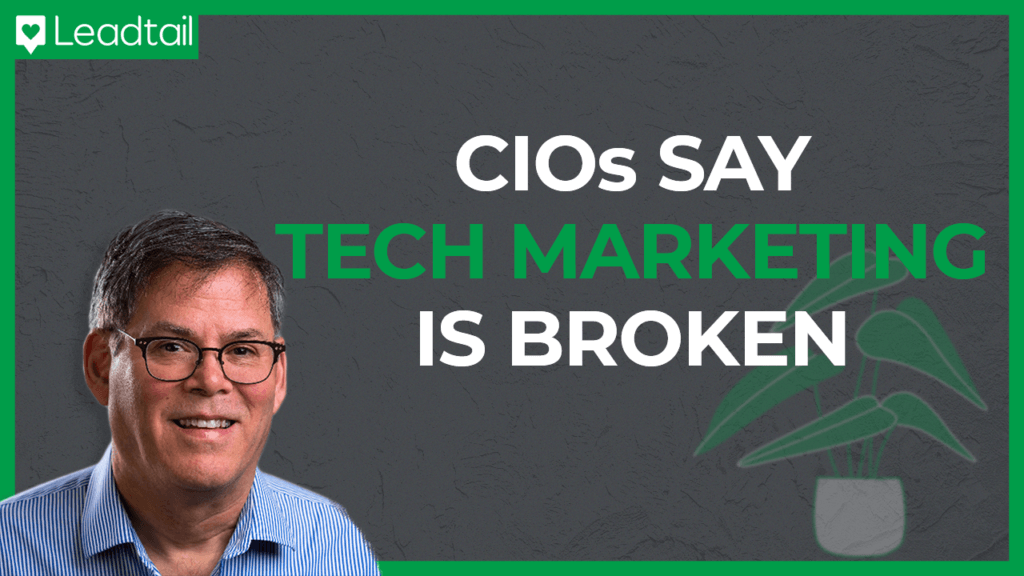There’s been a paradigm shift for marketers who want to sell CIOs on their product or solution.
“CIOs have moved from a utility way of thinking to more and more being focused on the transformation of their organizations,” Myles Suer, Director of Solutions Marketing at Alation, told Leadtail’s guests during a Spirited Conversations event.
Myles has a deep understanding of how CIOs think and how their role has changed. For the past five years, Myles has been involved with #CIOChat, a non-profit organization dedicated to CIO education and STEM diversity scholarships, mentorship, and internships. As part of his work with #CIOChat, Myles hosts a weekly Twitter chat and other events.
Today’s CIO is less focused on wonky tech granularities and more on the front-of-mind business needs shared by every leader in the C-suite.
CIOs are focused on aligning tech with business needs, and they speak the language of business rather than technology.
In other words, CIOs are business leaders who understand the particular ways technology fits into the overarching concerns of the company. That means technical descriptions of features and benefits don’t get marketers far with CIOs when it comes to purchasing decisions.
Because CIOs are focused on digital transformation for their companies, they think strategically about every investment they make, whether that means committing internal resources or making a purchase. And every decision is rooted in their desire for increased flexibility and agility as their teams are increasingly called upon to fill more varied roles throughout the organization.
Selling to CIOs
So, what does it take to communicate about products with technology decision-makers today?
“You shouldn’t be selling the product. You should be selling how you’re solving their pain point,” Myles says. Every message should use the language of solutions. What business problem is this going to solve? How will this solution help a company’s bottom line?
And the message needs to be delivered using language that business leaders can understand. Gone are the days of “buzzword bingo.” Jargon in the messaging turns off decision-makers and pushes interest in the pitch lower in the organization.
If you want to get your message across to the C-suite, you must use clear language that speaks to the solution value you provide for pain points the organization is experiencing.
There’s lots of marketing noise in the CIO inbox these days. Vendors that want to cut through the noise need clear messaging that speaks the customer’s language.
Creating tons of content and blasting it at prospects may result in some leads, but the most successful vendors will speak directly to customers to explain why they can help solve actual pain points CIOs see within their business.
“What’s the sense of urgency? Why is it ‘what we do’ solves the problem? And that creates the urgency to actually buy,” Myles explains.
What CIOs Are Looking For
CIOs want to develop partnerships with vendors they trust. They want partners who listen to their pain points, understand the business challenges that CIOs are tasked with overcoming, and who can articulate solutions that help them accomplish their objectives.
CIOs are looking for good digital assets to point them in the right direction. They want content that cuts through the noise. So marketing content has to address those desires to be effective.
Companies that can communicate their marketing messages in terms of solving real business problems will simply be more successful in winning over CIOs than those that don’t.
Myles says that CIOs tend to be reluctant to give their contact information to marketers. That’s because they’re so inundated with marketing content. As one of Myle’s CIO friends puts it, “Simply wanting information isn’t cause to spam me.”
CIOs want to do their research without inviting more noise into their inbox. So when they do offer their contact information, as they often will when they are provided the opportunity to attend a meaningful event, marketers must be careful about both the quality and the quantity of information they share.
How to Be a Partner
So, how can marketers come alongside CIOs as partners rather than merely sellers? Myles offers these suggestions.
- Move beyond talking about product features and functionality. “As much time and effort as you’ve put into creating that great product—or set of products—and its features and functionality, it’s time to move beyond that,” Myles says. “Understand why it’s useful and what it actually solves.”
- Provide content designed to demonstrate how the solution will benefit the CIO’s organization. It’s not just about ROI. Marketers need to provide clarity about how the product will impact the business. Again, the critical question is, “What problem does it solve?”
- Plot a realistic pathway to implementation and show how it provides business value. “It’s the business side of the equation which is critical when you’re doing very, very large deals,” Myles says. It takes more than a financial incentive for CIOs to change infrastructure, for example. There has to be a clear business impact.
- Be intentional about touch points with potential customers. To be successful with CIOs, marketers should be thoughtful about the ways they communicate with potential customers. In general, less is more, with successful marketers making fewer phone calls, sending fewer emails, and promoting fewer content assets. “They didn’t give you permission to contact them constantly,” Myles says of CIOs.
- Reinforce proof of concept by offering proof of value. Sales teams should help potential customers define the value they hope to achieve with a solution and then design a proof of concept around that particular business need.
- Drop the buzzwords. Instead of endless jargon, offer simple explanations that demonstrate how the solution relates to CIO pain points.
Marketing and sales teams that do these things well will cut through the noise to win over CIOs looking for partners to help them overcome business challenges in a continually evolving environment.
Watch Myles’ complete presentation on Leadtail TV.
Want to have a conversation about social media? Let’s talk.
